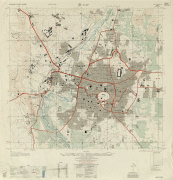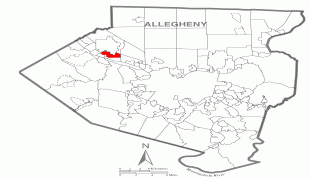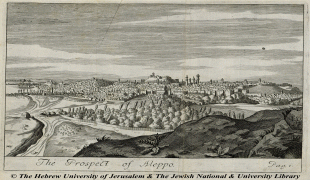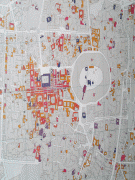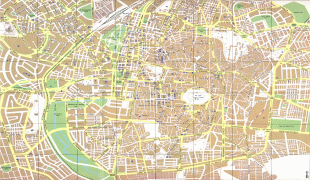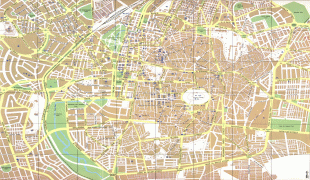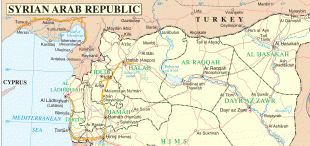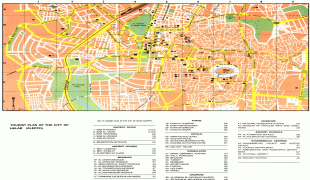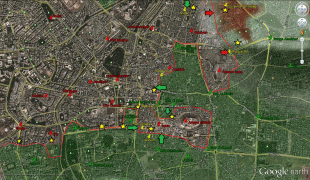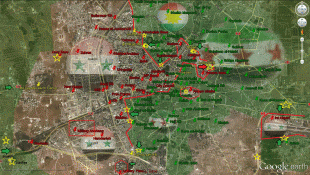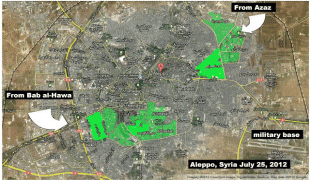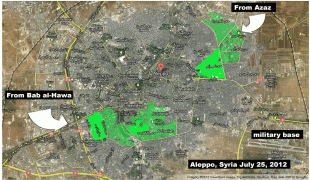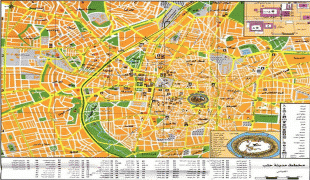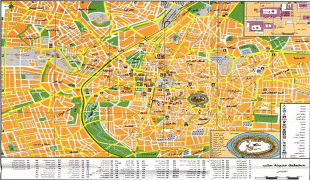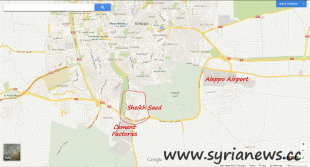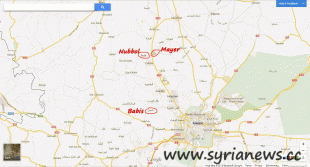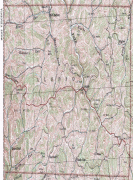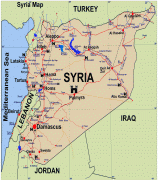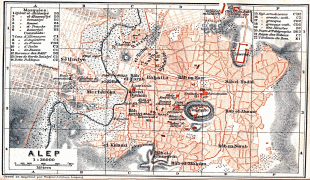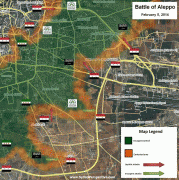Aleppo
Aleppo (ﺣَﻠَﺐ / ALA-LC: Ḥalab, ) is a city in Syria, which serves as the capital of the Aleppo Governorate, the most populous Governorate of Syria. With an estimated population of 2,098,000 residents it is Syria's second-largest city and also one of the largest cities in the Levant region.
Aleppo is one of the oldest continuously inhabited cities in the world; it may have been inhabited since the sixth millennium BC. Excavations at Tell as-Sawda and Tell al-Ansari, just south of the old city of Aleppo, show that the area was occupied by Amorites by the latter part of the third millennium BC. That is also the time at which Aleppo is first mentioned in cuneiform tablets unearthed in Ebla and Mesopotamia, which speak of it as part of the Amorite state of Yamhad, and note its commercial and military importance. Such a long history is attributed to its strategic location as a trading center between the Mediterranean Sea and Mesopotamia.
For centuries, Aleppo was the largest city in the Syrian region, and the Ottoman Empire's third-largest after Constantinople (now Istanbul) and Cairo. The city's significance in history has been its location at one end of the Silk Road, which passed through Central Asia and Mesopotamia. When the Suez Canal was inaugurated in 1869, much trade was diverted to sea and Aleppo began its slow decline. At the fall of the Ottoman Empire after World War I, Aleppo lost its northern hinterland to modern Turkey, as well as the important Baghdad Railway connecting it to Mosul. In the 1940s it lost its main access to the sea, by Antakya and İskenderun, also to Turkey. The growth in importance of Damascus in the past few decades further exacerbated the situation. This decline may have helped to preserve the old city of Aleppo, its medieval architecture and traditional heritage. It won the title of the Islamic Capital of Culture 2006, and has had a wave of successful restorations of its historic landmarks. The Battle of Aleppo (2012–2016) occurred in the city during the Syrian Civil War, and many parts of the city suffered massive destruction. Affected parts of the city are currently undergoing reconstruction. An estimated 31,000 people were killed in Aleppo during the conflict.
Modern-day English-speakers commonly refer to the city as Aleppo. It was known in antiquity as Khalpe, Khalibon, and to the Greeks and Romans as Beroea (Βέροια). During the Crusades, and again during the French Mandate for Syria and the Lebanon of 1923–1946, the name Alep was used. Aleppo represents the Italianised version of this.
The original ancient name, Halab, has survived as the current Arabic name of the city. It is of obscure origin. Some have proposed that Ḥalab means "iron" or "copper" in Amorite languages, since the area served as a major source of these metals in antiquity. Another possibility is that Ḥalab means 'white', as this is the word for 'white' in Aramaic. This may explain how Ḥalab became the Hebrew word for 'milk' or vice versa, as well as offering a possible explanation for the modern-day Arabic nickname of the city, ash-Shahbaa (الشهباء), which means "the white-colored mixed with black" and allegedly derives from the white marble found at Aleppo.
According to a folk etymology related by the twelfth century CE Rabbi Pethahiah of Regensburg and the Berber traveler Ibn Battuta, the name derives from חלב or ḥaleb because Abraham milked his sheep there to feed the poor.
From the 11th century it was common Rabbinic usage to apply the term "Aram-Zobah" to the area of Aleppo, and many Syrian Jews continue to do so.
Aleppo is one of the oldest continuously inhabited cities in the world; it may have been inhabited since the sixth millennium BC. Excavations at Tell as-Sawda and Tell al-Ansari, just south of the old city of Aleppo, show that the area was occupied by Amorites by the latter part of the third millennium BC. That is also the time at which Aleppo is first mentioned in cuneiform tablets unearthed in Ebla and Mesopotamia, which speak of it as part of the Amorite state of Yamhad, and note its commercial and military importance. Such a long history is attributed to its strategic location as a trading center between the Mediterranean Sea and Mesopotamia.
For centuries, Aleppo was the largest city in the Syrian region, and the Ottoman Empire's third-largest after Constantinople (now Istanbul) and Cairo. The city's significance in history has been its location at one end of the Silk Road, which passed through Central Asia and Mesopotamia. When the Suez Canal was inaugurated in 1869, much trade was diverted to sea and Aleppo began its slow decline. At the fall of the Ottoman Empire after World War I, Aleppo lost its northern hinterland to modern Turkey, as well as the important Baghdad Railway connecting it to Mosul. In the 1940s it lost its main access to the sea, by Antakya and İskenderun, also to Turkey. The growth in importance of Damascus in the past few decades further exacerbated the situation. This decline may have helped to preserve the old city of Aleppo, its medieval architecture and traditional heritage. It won the title of the Islamic Capital of Culture 2006, and has had a wave of successful restorations of its historic landmarks. The Battle of Aleppo (2012–2016) occurred in the city during the Syrian Civil War, and many parts of the city suffered massive destruction. Affected parts of the city are currently undergoing reconstruction. An estimated 31,000 people were killed in Aleppo during the conflict.
Modern-day English-speakers commonly refer to the city as Aleppo. It was known in antiquity as Khalpe, Khalibon, and to the Greeks and Romans as Beroea (Βέροια). During the Crusades, and again during the French Mandate for Syria and the Lebanon of 1923–1946, the name Alep was used. Aleppo represents the Italianised version of this.
The original ancient name, Halab, has survived as the current Arabic name of the city. It is of obscure origin. Some have proposed that Ḥalab means "iron" or "copper" in Amorite languages, since the area served as a major source of these metals in antiquity. Another possibility is that Ḥalab means 'white', as this is the word for 'white' in Aramaic. This may explain how Ḥalab became the Hebrew word for 'milk' or vice versa, as well as offering a possible explanation for the modern-day Arabic nickname of the city, ash-Shahbaa (الشهباء), which means "the white-colored mixed with black" and allegedly derives from the white marble found at Aleppo.
According to a folk etymology related by the twelfth century CE Rabbi Pethahiah of Regensburg and the Berber traveler Ibn Battuta, the name derives from חלב or ḥaleb because Abraham milked his sheep there to feed the poor.
From the 11th century it was common Rabbinic usage to apply the term "Aram-Zobah" to the area of Aleppo, and many Syrian Jews continue to do so.
Map - Aleppo
Map
Country - Syria
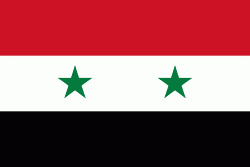 |
 |
| Flag of Syria | |
The name "Syria" historically referred to a wider region, broadly synonymous with the Levant, and known in Arabic as al-Sham. The modern state encompasses the sites of several ancient kingdoms and empires, including the Eblan civilization of the 3rd millennium BC. Aleppo and the capital city Damascus are among the oldest continuously inhabited cities in the world. In the Islamic era, Damascus was the seat of the Umayyad Caliphate and a provincial capital of the Mamluk Sultanate in Egypt. The modern Syrian state was established in the mid-20th century after centuries of Ottoman rule. After a period as a French mandate (1923–1946), the newly-created state represented the largest Arab state to emerge from the formerly Ottoman-ruled Syrian provinces. It gained de jure independence as a democratic parliamentary republic on 24 October 1945 when the Republic of Syria became a founding member of the United Nations, an act which legally ended the former French mandate (although French troops did not leave the country until April 1946).
Currency / Language
| ISO | Currency | Symbol | Significant figures |
|---|---|---|---|
| SYP | Syrian pound | £ or لس | 2 |
| ISO | Language |
|---|---|
| AR | Arabic language |
| HY | Armenian language |
| EN | English language |
| FR | French language |
| KU | Kurdish language |






